Mulberry family
| Mulberry family | ||||||||||||
|---|---|---|---|---|---|---|---|---|---|---|---|---|
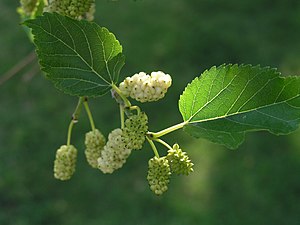
White mulberry fruit ( Morus alba ) |
||||||||||||
| Systematics | ||||||||||||
|
||||||||||||
| Scientific name | ||||||||||||
| Moraceae | ||||||||||||
| Gaudich. |
The mulberry family (Moraceae) are a family in the order of the rose-like (Rosales). It contains 37 to 40 genera and around 1100 (up to 1400) species. Species from this family are used in different ways. Many species of Ficus and their varieties are ornamental plants . Some species produce edible fruits and many species use wood.
Description and ecology
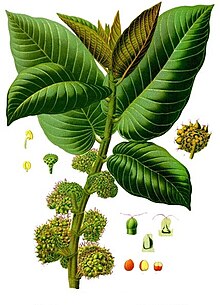
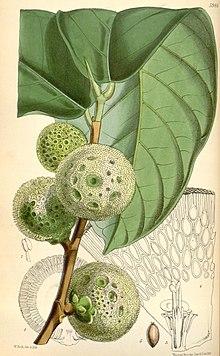
Appearance and leaves
They are mostly woody, more rarely annual ( Fatoua ) to perennial ( Dorstenia ) herbaceous plants . The spectrum of life forms in the woody Arte is varied: mostly evergreen or rarely deciduous, leptokaul (plants with relatively slim, richly branched stem axis ) to pachykaul (plants with thick, non- or slightly branched stem axis), trees , shrubs , half-shrubs , lianas . Some species grow as semi-epiphytic or succulents . All species contain a white or watery milky sap (latex), in Malaisia and Fatoua it is colored. The secondary growth in thickness is based on a conventional cambium ring.
The leaves are usually alternate, namely screwy or two-lined, rarely arranged opposite to each other on the branches or stems ( phyllotaxis ). The leaves are usually clearly divided into a petiole and a leaf blade. The appearance of the leathery to herbaceous, simple leaf blades is very variable: entire, toothed or lobed. There are always stipules that either stand free or, as in the case of Ficus , are fused and protect the young leaf.
Inflorescences, blossoms, fruits and seeds as well as synecology
The species are monoecious ( monoecious ) or dioecious ( dioecious ) separately sexed. The inflorescences, which are usually formed in pairs, contain either only flowers of one or both sexes. They can be paniculate , spiky or formed as heads ; sometimes many small individual flowers are combined to form a pseudo-flower (pseudanthium) surrounded by bracts , in which they are sometimes also grown together.
In the blooms , which are always unisexual , the bloom is reduced. If there is a perianth , then it is a simple perianth with usually four or five, rarely up to eight, mostly membranous, petals.
Male flowers contain one to three (to six) free stamens . In the flower bud, the stamens are bent inwards or straight.
The bracts of female flowers are often fused with each other or with the flower base; this is interpreted as an adaptation against phytophagous insects (predators). In female flowers are one to three, usually two carpels , from constant to constant above a usually one, rarely two-chambered ovary grown. The ovules are anatropic. In every female flower there is one or usually two styles that end in a single or two-column stigma .
The pollination is carried by the wind ( anemophily ) or by insects ( Entomophilie ). The original taxa are wind pollinated. Insect-pollinated taxa emerged at least twice. The taxa with inwardly curved stamens are wind-pollinated and when the flowers are opened the stamens jump outwards and release the pollen . The taxa with straight stamens are pollinated by insects. The genus Ficus contains about 750 species, more than half of the total species of the Moraceae and is characterized by a highly specialized inflorescence ("Sykonium") and an obligate (from Latin obligare for to bind, to oblige) symbiosis ( mutualism ) with the figs that pollinate them - Wasps that originated at least 80 to 90 million years ago.
The fruits are always lonely and stone fruits or ( achenae-like ) nut fruits and, more rarely, fruits with fleshy perianth are formed, which sometimes stand together in fruit associations or cluster fruits . The seeds can contain endosperm , which can be oil-containing. The straight or curved embryo has two germ layers ( cotyledons ), but usually one is reduced. The seed, the fruit, the fruit cluster or the fruit cluster act as a diaspore .
Chromosome numbers
The basic chromosome number is x = 7, 12 or 13 to many. The variation is particularly great at Dorstenia .
ecology
The fruits of many species are important food for many animal species.



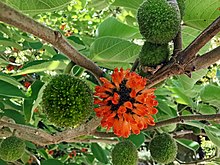


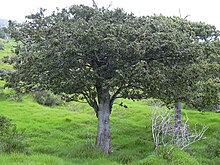
use
Some of the species ( Artocarpus , Ficus , Morus ) produce edible fruits. A few Morus and Maclura species are cultivated as forage plants for the silkworm ( Bombyx mori ). Many species ( Artocarpus , Broussonetia ) are used as suppliers for tropical wood and veneer production. Some Broussonetia , Maclura and Morus species provide the raw material for making paper .
Some species ( Ficus ) and their varieties are ornamental plants for parks, gardens and spaces.
Selected species used by humans:
- Breadfruit tree ( Artocarpus altilis )
- Jackfruit Tree ( Artocarpus heterophyllus )
- Paper mulberry tree ( Broussonetia papyrifera )
- Banyan fig ( Ficus benghalensis )
- Weeping fig ( Ficus benjamina )
- Common fig ( Ficus carica )
- Rubber tree ( Ficus elastica )
- Violin fig ( Ficus lyrata )
- Large-leaved fig ( Ficus macrophylla )
- Poplar fig ( Ficus religiosa )
- Mulberry fig ( Ficus sycomorus )
- Milky orange tree or Osage thorn ( Maclura pomifera )
- Sycamore tree ( Maclura tinctoria )
- White Mulberry ( Morus alba )
- Black Mulberry ( Morus nigra )
- Red Mulberry ( Morus rubra )
- Streblus asper
Systematics and distribution
The Moraceae are found largely worldwide, with centers of biodiversity in the Old World, particularly in Asia and the islands of the Indonesian Archipelago and the Pacific.
The family name Moraceae was first published in 1835 by Charles Gaudichaud-Beaupré in Genera Plantarum ad Familias Suas Redacta , 13. The type genus is Morus L. Synonyms for Moraceae Gaudich. nom. cons. are: Artocarpaceae Bercht. & J. Presl , Ficaceae Bercht. & J. Presl .
Molecular genetic studies showed that the six or seven families of the earlier order Urticales also belong to the order Rosales . The Moraceae family is the sister group of the Urticaceae , with which it shares some flower characteristics.
Related families within the order Rosales:
| Rosales |
|
||||||||||||||||||||||||
|
|
According to Datwyler & Weiblen 2004, the Moraceae are divided into five tribes , particularly due to specific flower characteristics . The Moraceae family contains 37 to 40 genera with around 1100 (up to 1400) species:
- Tribe Artocarpeae R.Br. : It contains seven (earlier to twelve) genera with about 87 species:
- Breadfruit trees ( Artocarpus J.R.Forst. & G.Forst. ) : The 47 to 50 species are common in Asia and the Indo-Pacific region .
- Batocarpus H.Karst. : The fouror sospecies are common in the tropics of Africa and Asia.
-
Clarisia Ruíz & Pav .: The only three types are common in the Neotropic.
- Clarisia racemosa Ruiz & Pav .: From central to northern South America to Central America
- Hullettia King ex Hook.f. : The only two types are common in Southeast Asia.
- Parartocarpus Baill. : The only three species are common in the Indo-Pacific region.
- Prainea King : The four or so species are common in the Indo-Pacific region.
-
Treculia Decne. ex Trécul : The only three species are common in tropical Africa, for example:
- Treculia africana Decne. ex Trécul
- Tribe Castilleae Berg : It contains (previously eight) about ten genera:
-
Antiaris Lesch. : It contains only one type:
- Antiaris toxicaria Lesch. : The four subspecies arewidespreadin the tropics of Africa, Asia and Australia .
- Antiaropsis K. Schum. : It contains only one or two species in New Guinea .
- Castilla Cerv. : The approximately three types are common in the Neotropic.
- Helicostylis Trécul : The seven or so species are common in the Neotropic.
- Maquira Aubl. : The five or so species are common in the Neotropics.
-
Mesogyne Engl .: It contains only one species:
- Mesogyne insignis Engl .: It occurs in tropical Africa.
- Naucleopsis Miq. : The approximately 20 species are common in the Neotropic.
- Perebea Aubl. : common about nine species are common in the Neotropic.
-
Poulsenia Eggers : It only contains one species:
- Poulsenia armata (Miq.) Standl. : It occurs in the Neotropic.
- Pseudolmedia Trécul : The nine or so species are common in the Neotropic.
- Sparattosyce Bureau : The two or so species are only found in New Caledonia .
-
Antiaris Lesch. : It contains only one type:
- Tribus Dorstenieae Gaudich. : It contains about eight genera:
-
Bosqueiopsis De Wild. & T.Durand : It contains only one species:
- Bosqueiopsis gilletii De Wild. & T.Durand : It occurs in tropical Africa.
-
Brosimum Sw. : The approximately 13 species are common in the Neotropic.
- American cow tree ( Brosimum utile (Kunth) Pittier )
- Dorstenia ( Dorstenia L. ): Of the 105 to 170 species, 57 occur in tropical Africa, 46 in tropical America and one in southern India and Sri Lanka , the latter and 18 African species are succulent .
- Helianthostylis Baill. : The only two species common in the Neotropic.
- Scyphosyce Baill. : The only two types are common in tropical Africa.
-
Trilepisium Thouars : It contains only one species:
- Trilepisium madagascariense DC. : It occurs in tropical as well as southern Africa and Madagascar.
- Trymatococcus Poepp. & Endl. : The only three species common in the Neotropic.
- Utsetela Pellegr. : It contains only one or two species in tropical Africa.
-
Bosqueiopsis De Wild. & T.Durand : It contains only one species:
- Tribus Ficeae Gaudich. : With the only genus:
- Figs ( Ficus L. ): The approximately 750 species are distributed worldwide in the tropics. For example, there are 44 species in Australia and about 99 species in China.
- Tribus Moreae Gaudich. : It contains (previously eight) ten genera and around 70 species:
-
Bagassa Aubl. : It contains only one type:
- Bagassa guianensis Aubl. : It occurs in the Neotropic.
- Bleekrodea flower : The only three species occur in Madagascar and Southeast Asia .
- Broussonetia L'Hér. ex Vent. : The eight or so species occur in Madagascar and Southeast Asia.
- Fatoua Gaudich. : The only two or three species are common in Asia, Australia (one species) and Madagascar. They are annual herbaceous plants.
- Maclura Nutt. : The (one to) about eleven species are distributed worldwide in the tropics and in North America.
- Milicia Sim : The only two species are common in tropical Africa.
- Mulberries ( Morus L. ): The twelve or so species are common in temperate and subtropical zones of the northern hemisphere.
- Sorocea A.St.-Hil. : The approximately 14 species are common in the Neotropic.
- Streblus Lour. : The approximately 22 species occur in Asia, Australia, Africa and Madagascar.
-
Trophis P.Browne : The three to nine kinds occur in the Neotropic, Southeast Asia and Australia (one kind). Including:
- Trophis montana (Leandri) CC Mountain
-
Bagassa Aubl. : It contains only one type:
As DNA analyzes of different working groups show, the genera Artocarpus , Batocarpus , Brosimum , Castilla , Streblus and Trophis are not monophyletic , since some of their species correspond to different tribes and therefore require further processing.
swell
- The Moraceae family on the AP website. (Section description and systematics)
- the Moraceae family at DELTA by L. Watson & MJ Dallwitz. (Section description)
- The Moraceae family at Western Australian Flora .
- Zhengyi Wu, Zhe-Kun Zhou, Michael G. Gilbert: Moraceae. Pp. 21–29 - the same text online as the printed work , In: Wu Zhengyi, Peter H. Raven, Deyuan Hong (eds.): Flora of China. Volume 5: Ulmaceae through Basellaceae. Science Press and Missouri Botanical Garden Press, Beijing and St. Louis, December 19, 2003, ISBN 1-930723-27-X . (Section Description and Use)
- Nyree JC Zerega, Wendy L. Clement, Shannon L. Datwyler, George D. Weiblen: Biogeography and divergence times in the mulberry family (Moraceae). In: Molecular Phylogenetics and Evolution. , Volume 37, 2005, pp. 402-416: full text PDF.
- JG Rohwer: Moraceae. In: K. Kubitzki u. a. (Ed.): Families and genera of vascular plants. Volume 2, 1993, pp. 506-515.
- Shannon Datwyler, George D. Weiblen: On the origin of the fig: Phylogenetic relationships of Moraceae from ndhF sequences. In: American Journal of Botany. , Volume 91, Issue 5, 2004, pp. 767-777. Full text - online. (Section description and systematics)
- Richard P. Wunderlin: Moraceae. - Same text online as the printed work , In: Flora of North America Editorial Committee (Ed.): Flora of North America North of Mexico. Volume 3: Magnoliidae and Hamamelidae. Oxford University Press, New York and Oxford, 1997, ISBN 0-19-511246-6 (Description section)
- EJH Corner: The classification of Moraceae. In: Gard. Bull. Straits Settlem. 19, 1962, pp. 187-252.
- DJ Dixon: Moraceae. 2011, In: PS Short, ID Cowie (Ed.): Flora of the Darwin Region . Full text PDF.
- CC Berg, EJH Corner, FM Jarrett: Moraceae genera other than Ficus. In: HP Nooteboom, (Ed.): Flora Malesiana. (Foundation Flora Malesiana), Ser. 1, Volume 17, 2006, pp. 1–152.
Individual evidence
- ↑ Urs Eggli (Ed.): Succulents Lexicon. Volume 2: Dicotyledons (dicotyledons) except Aizoaceae, Asclepiadaceae, Cactaceae and Crassulaceae. Eugen Ulmer Verlag, Stuttgart 2002, ISBN 3-8001-3915-4 .
- ↑ Nyree JC Zerega, Wendy L. Clement, Shannon L. Datwyler, George D. Weiblen: Biogeography and divergence times in the mulberry family (Moraceae). In: Molecular Phylogenetics and Evolution. , Volume 37, 2005, pp. 402-416: Online. ( Memento from July 24, 2008 in the Internet Archive )
- ↑ Moraceae in the Germplasm Resources Information Network (GRIN), USDA , ARS , National Genetic Resources Program. National Germplasm Resources Laboratory, Beltsville, Maryland.
- ↑ Kenneth J. Sytsma, Jeffery Morawetz, J. Chris Pires, Molly Nepokroeff, Elena Conti, Michelle Zjhra, Jocelyn C. Hall, Mark W. Chase: Urticalean rosids: circumscription, rosid ancestry, and phylogenetics based on rbcL, trnL-F , and ndhF sequences. In: American Journal of Botany. , Volume 89, 2002, pp. 1531-1546: Online.
- ^ The Moraceae family on the AP website.
- ↑ a b Shannon Datwyler, George D. Weiblen: On the origin of the fig: Phylogenetic relationships of Moraceae from ndhF sequences. In: American Journal of Botany. , Volume 91, Issue 5, 2004, pp. 767-777. Full text - online.
Web links
- Profiles of mulberry plants.
- Profiles of mulberry plants.
- Profiles of mulberry plants. (English)
- Profiles of mulberry plants. (span.)
- Antiaris toxicaria profile (www.giftpflanze.org)

